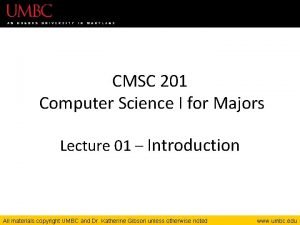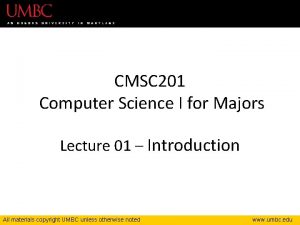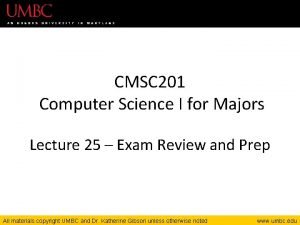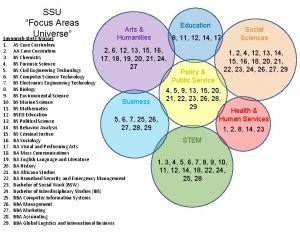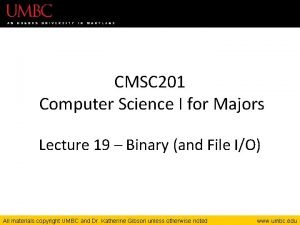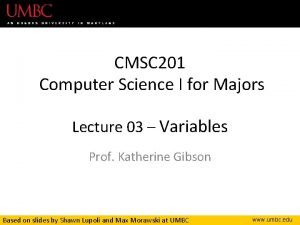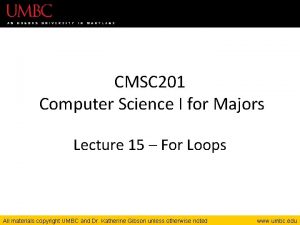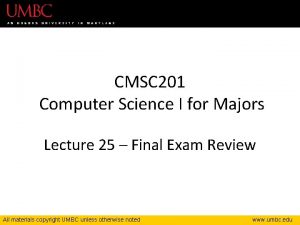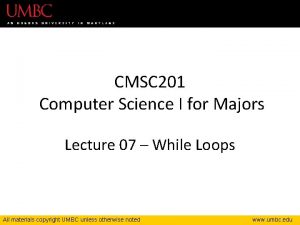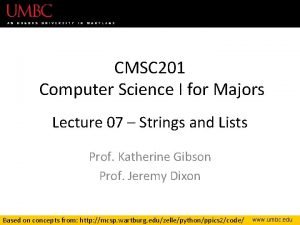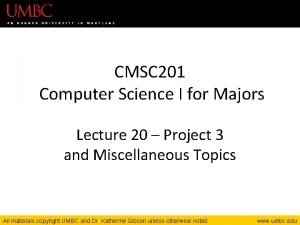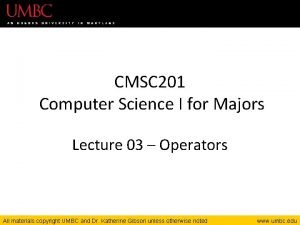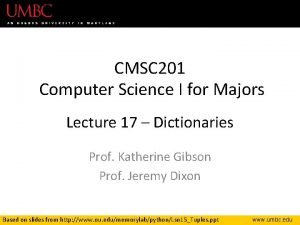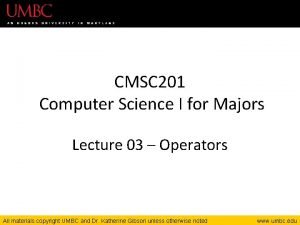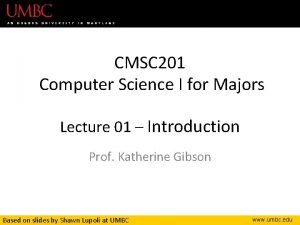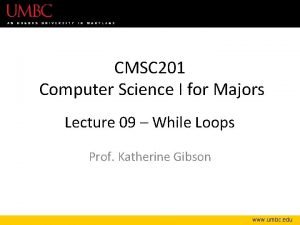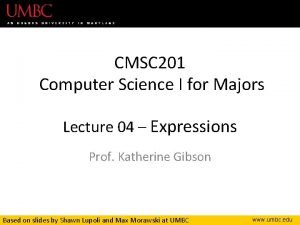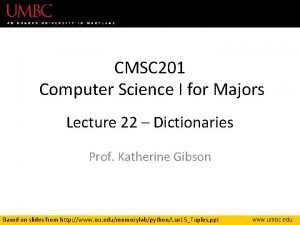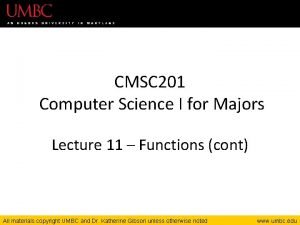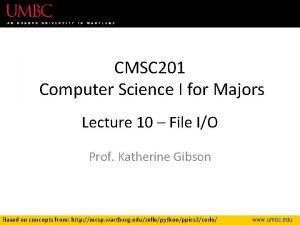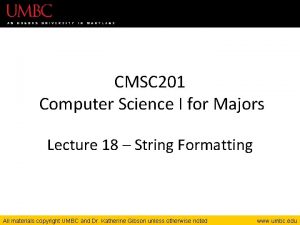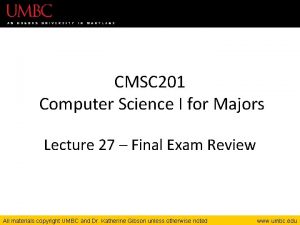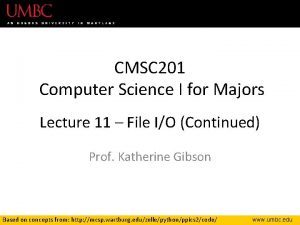CMSC 201 Computer Science I for Majors Lecture


































- Slides: 34

CMSC 201 Computer Science I for Majors Lecture 20 – Classes and Modules Prof. Katherine Gibson Prof. Jeremy Dixon Based on slides from the book author, and previous iterations of the course www. umbc. edu

Last Class We Covered • Stacks • Recursion – Recursion • Additional examples – Summation – Hailstone Example (Collatz) 2 www. umbc. edu

Any Questions from Last Time? www. umbc. edu

Today’s Objectives • To reinforce what exactly it means to write “good quality” code • To learn about importing • To better understand the usefulness of modules • To learn what a class is, and its various parts – To cover vocabulary related to classes – To be able to create instances of a class 4 www. umbc. edu

“Good Code” • If you were to ask a dozen programmers what it means to write good code, you would get a different answer from each • What are some characteristics that we have discussed that help you write “good code? ” 5 www. umbc. edu

8 Characteristics of Good Code 1. Readability – As we previously discussed, writing code that is easy to understand what it is doing 2. Adaptability (or Extensibility) – Relates to how easy it is to change conditions or add features or functionality to the code 3. Efficiency – Clean code is fast code 6 From: http: //www. codeexcellence. com/2012/05/8 -must-have-characteristics-for-writing-quality-code/ www. umbc. edu

8 Characteristics of Good Code 4. Maintainability – Write it so other people can read it! 5. Well Structured – How well do the different parts of the code work together? Is there a clear flow to the program? 6. Reliability – Code is stable and causes little downtime 7 From: http: //www. codeexcellence. com/2012/05/8 -must-have-characteristics-for-writing-quality-code/ www. umbc. edu

8 Characteristics of Good Code 7. Follows Standards – Code follows a set of guidelines, rules and regulations that are set by the organization 8. Regarded by Peers – Good programmers know good code – You know you are doing a good programming job when your peers have good things to say about your code 8 From: http: //www. codeexcellence. com/2012/05/8 -must-have-characteristics-for-writing-quality-code/ www. umbc. edu

Importing and Modules www. umbc. edu

Reusing Code • If we take the time to write a good function, we might want to reuse it later! • It should have the characteristics of good code – Clear, efficient, well-commented, and reliable – Should be exhaustively tested to ensure that it performs exactly as we want it to • Reusing bad code causes problems in new places! 10 www. umbc. edu

Modules • A module is a Python file that contains definitions (of functions) and other statements – Named just like a regular Python file: my. Module. py • Modules allow us to easily reuse parts of our code that may be generally useful – Functions like is. Prime(num) or get. Valid. Input(min, max) 11 www. umbc. edu

Importing Modules • To use a module, we must first import it • There are three different ways of importing: import somefile from somefile import * from somefile import class. Name • The difference is what gets imported from the file and what name refers to it after importing 12 www. umbc. edu

import • In Lab 9, when we practiced using pdb (Python debugger), we used the import command import pdb • This command imports the entire pdb. py file – Every single thing in the file is now available – This includes functions, classes, constants, etc. 13 www. umbc. edu

import • To use things we’ve imported this way, we need to append the filename and a period to the front of its name (“my. Module. ”) • To access a function called my. Function: my. Module. my. Function(34) • To access a class method: my. Module. my. Class. class. Method() 14 www. umbc. edu

from some. File import * • Again, everything in the file some. File. py gets imported (we gain access to it) – The star (*) means we import every single thing from some. File. py • Be careful! – Using this import command can easily overwrite an existing function or variable 15 www. umbc. edu

from some. File import * • When we use this import, if we want to refer to anything, we can just use its name • We no longer need to use “some. File. ” in front of the things we want to access my. Function(34) my. Class. class. Method() 16 www. umbc. edu

from some. File import X • Only the item X in some. File. py is imported • After importing X, you can refer to it by using just its name (no some. File. ) • But again, be careful! – This would overwrite anything that is also called X 17 www. umbc. edu

from some. File import X from my. Module import my. Class • We have imported this class and its methods my. Class. class. Method() • But not the other things in my. Module. py my. Function(34) (not imported) • We can import multiple things using commas: from my. Module import thing 1, thing 2 18 www. umbc. edu

Where to Import From? • Where does Python look for module files? • In the current directory • In a list of pre-defined directories – These directories are where libraries like random and pdb are stored 19 www. umbc. edu

Object Oriented Programming: Defining Classes www. umbc. edu

Classes • A class is a special data type which defines how to build a certain kind of object. • The class also stores some data items that are shared by all the instances of this class • Classes are blueprints for something • Instances are objects that are created which follow the definition given inside of the class www. umbc. edu

Classes • In general, classes contain two things: 1. Attributes of an object (data members) • Usually variables describing the thing 2. Things that the object can do (methods) • Usually functions describing the action www. umbc. edu

Class Parts • Data member: A class variable or instance variable that holds data associated with a class and its objects. • Method: A special kind of function that is defined in a class definition. www. umbc. edu

Instances of a Class • Object: A unique instance of a data structure that's defined by its class. An object comprises both data members (class variables and instance variables) and methods. www. umbc. edu

Class Description • If a class describes a thing, we can think about it in terms of English – Object -> Noun – Attribute -> Adjective – Method (Function) -> Verb www. umbc. edu

Class Example class Dog: def __init__(self, name): self. name = name self. tricks = [] # creates a new empty list for each dog def add_trick(self, trick): self. tricks. append(trick) >>> d = Dog('Fido') >>> e = Dog('Buddy') >>> d. add_trick('roll over') >>> e. add_trick('play dead') >>> d. tricks ['roll over'] >>> e. tricks ['play dead'] From: https: //docs. python. org/2/tutorial/classes. html Creates an instance of dog (called an object) Refer to Fido as “d” from then on Add a trick to Fido called ‘roll over’ www. umbc. edu

Class to build dogs Class Example class Dog: def __init__(self, name): self. name = name self. tricks = [] # creates a new empty list for each dog def add_trick(self, trick): self. tricks. append(trick) >>> d = Dog('Fido') >>> e = Dog('Buddy') >>> d. add_trick('roll over') >>> e. add_trick('play dead') >>> d. tricks ['roll over'] >>> e. tricks ['play dead'] From: https: //docs. python. org/2/tutorial/classes. html Characteristic of dog Method (function) to add tricks Creating a new dog named ‘Fido’ www. umbc. edu

Defining a Class • Instances are objects that are created which follow the definition given inside of the class • Python doesn’t use separate class interface definitions as in some languages • You just define the class and then use it www. umbc. edu

Everything an Object? • Everything in Python is really an object. – We’ve seen hints of this already… “hello”. upper() list 3. append(‘a’) – New object classes can easily be defined in addition to these built-in data-types. • In fact, programming in Python is typically done in an object-oriented fashion. www. umbc. edu

Methods in Classes • Define a method in a class by including function definitions within the scope of the class block • There must be a special first argument self in all of method definitions which gets bound to the calling instance • There is also usually a special method called __init__ in most classes • We’ll talk about both later… www. umbc. edu

Class Example student class student: def __init__(self, n, a): self. full_name = n self. age = a def get_age(self): return self. age www. umbc. edu

Using Class Student Create new student object (a) with name “John”, age 19 def main(): a = student("John", 19) Print an attribute of print(a. full_name) the student print(a. get_age()) Call a method of student main() Output bash-4. 1$ python class_student. py John 19 bash-4. 1$ www. umbc. edu

Any Other Questions? www. umbc. edu

Announcements • Project 1 is out – Due by Monday, April 18 th at 8: 59 PM – No extensions! • Final exam: Common Final 34 – Friday, May 13 th from 6 to 8 PM – Location of the exam depends on your section – If you have religious/sports exemptions that prevent you from taking the exam then, let us know ASAP! www. umbc. edu
 Cmsc 201 umbc
Cmsc 201 umbc Cmsc 201
Cmsc 201 Cmsc 201
Cmsc 201 01:640:244 lecture notes - lecture 15: plat, idah, farad
01:640:244 lecture notes - lecture 15: plat, idah, farad Tem 4
Tem 4 Base details theme
Base details theme Gju majors
Gju majors Savannah state university majors
Savannah state university majors Uwlax majors
Uwlax majors Psychology texas state
Psychology texas state Uwb advisor appointment
Uwb advisor appointment Ung ap credit
Ung ap credit Skyline college map
Skyline college map Wku academic advising
Wku academic advising Umn majors
Umn majors What is your favorite subject what subject
What is your favorite subject what subject Physical science lecture notes
Physical science lecture notes Computer security 161 cryptocurrency lecture
Computer security 161 cryptocurrency lecture Computer aided drug design lecture notes
Computer aided drug design lecture notes Computer architecture notes
Computer architecture notes Microarchitecture vs isa
Microarchitecture vs isa Formuö
Formuö Typiska drag för en novell
Typiska drag för en novell Nationell inriktning för artificiell intelligens
Nationell inriktning för artificiell intelligens Returpilarna
Returpilarna Varför kallas perioden 1918-1939 för mellankrigstiden
Varför kallas perioden 1918-1939 för mellankrigstiden En lathund för arbete med kontinuitetshantering
En lathund för arbete med kontinuitetshantering Personalliggare bygg undantag
Personalliggare bygg undantag Personlig tidbok för yrkesförare
Personlig tidbok för yrkesförare Anatomi organ reproduksi
Anatomi organ reproduksi Förklara densitet för barn
Förklara densitet för barn Datorkunskap för nybörjare
Datorkunskap för nybörjare Tack för att ni lyssnade bild
Tack för att ni lyssnade bild Hur skriver man en debattartikel
Hur skriver man en debattartikel Magnetsjukhus
Magnetsjukhus
